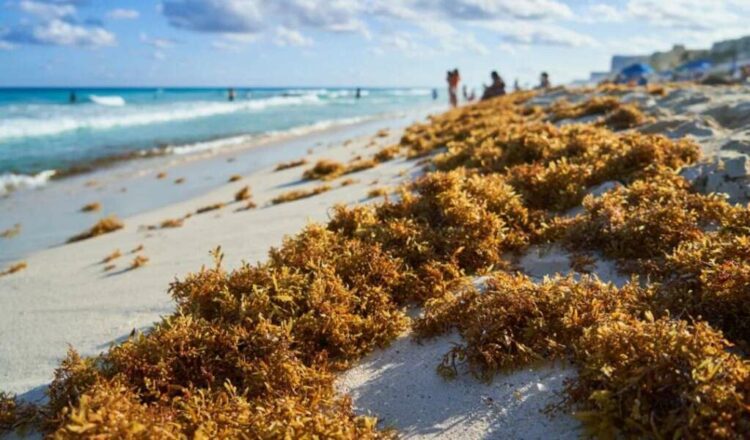A picture of sargassum on a beachin Florida. (Photo: Sarasota Magazine)
Among the more important environmental stories over recent days relates to the planned establishment in Grenada of a regional secretariat and information hub to help cope with the floating Sargassum seaweed threat to regional economies.
The Caribbean Media Corporation (CMC) tells us that the plans were announced by Grenada’s Prime Minister Mr Dickon Mitchell at the close of a two-day conference funded by the European Union, themed ‘Turning the Tide: Sustainable Practices and Economic Opportunities for Sargassum in the Caribbean Basin’.
Environmentalists say that Sargassum has long existed in the mid-Atlantic Ocean, Caribbean Sea, and Gulf of Mexico, providing an important source of nutrients for marine and beach life.
However, human interventions have changed all that.
Since 2011, massive “islands” of sea weed have been drifting into the Caribbean and the Gulf undermining marine life, fishing industries, damaging mangroves, and clogging beaches.
On shore, the great mats of seaweed rapidly degrade into smelly, odious, health-hazardous, insect-filled mess, repelling beachgoers and endangering life-giving tourism.
Agricultural and industrial pollutants, including fertilisers and other chemicals washed into the Atlantic by the great rivers of South America, Africa, and North America, are believed to be major contributors to the rapid growth of floating Sargassum this century, and more especially over the last decade.
Logging and wider deforestation which loosens soil, enabling its loss to rushing rivers and eventually the sea, as well as Sahara dust, and other climatic and environmental influences are also factors, experts say.
Relatively protected geographically though it is, in the north-central Caribbean, Jamaica has had its fair share of problems with Sargassum.
The situation is well nigh calamitous for the unprotected chain of islands to the east, which form the eastern boundary of the Caribbean Sea.
Research as well as small projects done so far have suggested there is economic value in Sargassum through its use in manufacturing of fertilisers, animal feed, and even construction materials.
But there is much work to be done, and meantime regional economies must be protected.
In 2018, which was a very bad year in terms of Sargassum invasion of Caribbean shores, regional clean-up was estimated at US$120 million.
Mr Mitchell told the recent two-day conference that setting up of the regional secretariat and information hub was critical to ensuring that “we (Caribbean countries) have a central coordinating body for policy development, research, collaboration, and sustainable management of Sargassum efforts throughout the region”.
All too often members of the Caribbean Community and the wider region have talked the good talk while falling flat at implementation time.
That must not happen in the face of this ongoing environmental threat.
This newspaper is at one with the director general of the Organisation of Eastern Caribbean States Commission Dr Didacus Jules, that “Sargassum knows no boundaries and neither should our response …the influxes that we face require not only national efforts but a coordinated regional strategy. We need to work together on forecasting, collections, storage and processing.”
All of us, not least regional media, should do our part in making sure the anticipated “coordinated regional strategy” becomes reality.
Source link : http://www.bing.com/news/apiclick.aspx?ref=FexRss&aid=&tid=6703c5a754384472893379cf70f0006d&url=https%3A%2F%2Fwww.jamaicaobserver.com%2F2024%2F10%2F07%2Fregional-cooperation-must-combat-sargassum-threat%2F&c=16277297375539987935&mkt=en-us
Author :
Publish date : 2024-10-06 23:32:00
Copyright for syndicated content belongs to the linked Source.
